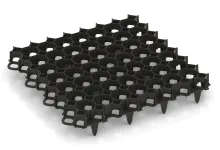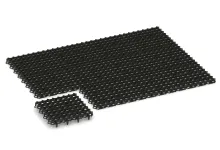Interlocking playground safety tile TZ "Travertine"
- /
-
Delivery in approx.
7-14 days - £59.20 / 4 Piece / m²
- (5.78 kg / Piece)
EAN: 4251469326354 | Item no.: 2635
The WARCO interlocking playground safety tile provides certified protection wherever slips and minor falls need to be cushioned – on playgrounds, in nurseries and schools, on terrace play areas, and in community spaces. With certified protection for fall heights of up to 100 cm in accordance with EN 1177 (at a thickness of 4 cm), it is ideal for circulation and play areas that do not feature high climbing frames or raised platforms. In senior care facilities, rehabilitation centres and fitness areas, the elastic, interlocking tiles are a proven flooring option that delivers safety, comfort and cost efficiency.
Typical applications:
– Play zones for young children, balance and activity areas
– Schoolyards, nurseries and municipal sites
– Terraces with play equipment or seating areas
– Fitness and outdoor fitness zones
– Senior residences, nursing care, rehabilitation and therapy rooms
Material & structure:
The tiles are manufactured from PU-bonded rubber granulate and feature a resilient, slip-resistant surface. Available in 3 or 4 cm thicknesses, they provide dependable shock absorption with a low build-up height. Precision-cut interlocking puzzle edges ensure a secure, form-fitting connection, while a slight edge bevel creates a calm, tidy joint appearance.
Connection & installation
The tiles are laid floating and joined via the interlocking puzzle edges. This produces a dimensionally stable, form-fitting surface with aligned joints (stack bond/cross joints) suitable for both indoor and outdoor use. The handy 50 × 50 cm format makes installation simple and requires no specialist tools.
Properties & safety
The tiles are slip-resistant in wet and dry conditions, water-permeable and resilient. Rainwater can either infiltrate the subgrade or drain through the integrated drainage channels on a bound base layer beneath the tiles. This prevents puddles or dust patches from forming, ensuring the surface remains usable all year round. Outdoors, unbound sub-bases (e.g. plastic honeycomb grids or gravel grids) help to prevent soil sealing.
Maintenance & economy
Maintenance is straightforward: rainfall rinses away light soiling, while heavier dirt can be swept or blown off. Cleaning with a mop, a pressure washer or professional floor-cleaning equipment is also possible. Individual tiles can be replaced if required. The modular system keeps costs predictable, making the interlocking safety tile a durable and economical choice for many applications.
Discount
Product Highlights
Characteristics
Product Details – Material and Structure
Comparative values
To calculate how many tiles you need for your project, simply use the online installation planner available in the shop. This free browser-based tool is directly accessible on each product page – just below the price and quantity selection. Click on “Plan installation” to open the tool instantly – no registration or download required.
Enter the dimensions of your area, such as the length and width in metres. The planner will then automatically calculate the total number of tiles required, including a realistic allowance for offcuts. You’ll also be shown a suitable layout pattern for the selected product. The tool is user-friendly, accurate and ideal for planning your material requirements with confidence.
Proper installation is essential to ensure the performance, safety and longevity of Playground Safety Mats and Playground Safety Tiles. The recommended method depends on the intended use, the condition of the sub-base and the specific product type.
Suitable sub-base – stable, level and free-draining
For outdoor installations, WARCO recommends a long-term stable, water-permeable base layer. Proven options include plastic ground reinforcement grids (gravel stabilisation panels) or an existing bound and porous sub-base such as porous concrete. If the base is not permeable, exposed surfaces must include a drainage gradient of at least 1.5 %. Installation on loose materials like sand, gravel or crushed stone is not recommended, as these tend to shift under resilient rubber tiles.
Laying pattern and connection systems
Depending on the product, tiles are installed in a half-bond or cross-bond pattern. WARCO offers two connection systems: plastic alignment dowels or form-fitting interlocking profiles. Especially the interlocking system ensures dimensional stability and prevents lateral displacement of the surface.
Cutting and fitting
Tiles can be trimmed to size using a circular saw or jigsaw (with blades suitable for rubber or wood), or a sharp utility knife. Accurate cuts and clean joins are especially important at edges, transitions and around fixed structures.
Edge finishing and trip protection
All exposed edges should be finished using bevelled or ramp-edge tiles to eliminate trip hazards. In public areas such as playgrounds, edging with kerbstones, frame profiles or flat perimeter barriers is recommended – and mandatory when using systems with plastic dowels.
Adhesive fixing and edge bonding (optional)
On solid surfaces like concrete or asphalt, tiles may be spot- or fully bonded using a single-component polyurethane adhesive. Edge tiles can also be bonded to each other to further stabilise the area. Ramped and corner tiles with bevelled profiles should always be glued down on firm substrates.
Installation under suitable conditions
Installation should be carried out at ambient temperatures between 5 °C and 17 °C. The material must be dry and acclimatised before laying. Avoid installing in direct sunlight or at temperatures above 18 °C, as the tiles may expand during handling and compromise the fit.
WARCO offers several connection systems for floor tiles, each differing in design, installation method and visual appearance. Below is an overview of the key differences:
Puzzle joint (visible)
In this system, the tile edges feature an interlocking profile reminiscent of classic jigsaw teeth or mushroom-shaped connectors. During installation, the profiles of adjacent tiles interlock to form a continuous connection across the full tile thickness.
The joint profile may be formed directly during pressing or precisely cut after the tile has cured. Whether the joint is visible in the finished surface depends on the edge finish (e.g. with or without chamfer) and the surface colouration.
The symmetrical shape ensures uniform load transfer and makes this type of joint the most mechanically stable option.
Plug-in connectors (plastic dowels)
This system uses separate connecting elements, typically round plastic dowels, which are inserted into pre-drilled holes along the sides of the tiles. The tiles themselves have smooth, straight edges similar to precast concrete slabs.
Installation is carried out in a half-bond (stretcher bond) pattern: each tile is connected via dowels to two tiles in the row above and two in the row below. This prevents lateral shifting, although some movement along the length of the dowels remains possible. For this reason, an edge restraint must be installed around the perimeter to stabilise the entire area.
Concealed puzzle joint
This method is based on the same mechanical principle as the classic puzzle joint, but is designed to be invisible in the finished surface. The interlocking profile is located on the underside of the tile, integrated into a rebated step joint.
Two tile edges feature a positive locking profile, the other two a matching negative profile. When laid, the tiles interlock securely from below, forming a durable mechanical connection. From above, the surface appears seamless and aligned, typically with a clean, square joint pattern similar to a chessboard layout.
Playground Safety Mats and Playground Safety Tiles are primarily made from elastic rubber granulate that is permanently bonded using a polyurethane binder. They are designed to reliably absorb impact from falls while providing a durable, non-slip surface – both indoors and outdoors.
Core material: ELT rubber granulate
The base material is usually cleaned and shredded rubber from end-of-life tyres, known as ELT granulate. The granules are screened, cleaned and graded before processing. The grain size – from fine to medium – affects both the appearance and mechanical properties of the finished tile.
Binder: Polyurethane (PU)
The granules are mixed with a high-quality polyurethane binder and compressed into shape under pressure. PU remains permanently elastic, UV-resistant and has excellent bonding strength. It is colourless or coloured, low-emission and safe for health.
Surface layer: Optional EPDM topping
For Playground Safety Tiles with enhanced design appeal, a top layer of EPDM granules is applied to the ELT base. EPDM is a durable, synthetic rubber available in many colours and specifically developed for use in outdoor safety surfacing. These tiles combine high shock absorption with attractive appearance and improved weather resistance.
Material properties
Playground Safety Mats and Tiles made from rubber granulate are slip-resistant, water-permeable, resilient and frost-resistant. They absorb vibration and structure-borne sound and offer a comfortable surface feel. Depending on the model, they are certified for critical fall heights of up to 3 m in accordance with DIN EN 1177.
Certified safety – tested materials
WARCO uses only clean, controlled rubber granulate and tested PU binders of certified quality. All Playground Safety Mats and Tiles are low-emission, tested for harmful substances and highly durable – making them a cost-effective long-term solution.
The required thickness of Playground Safety Mats and Tiles depends on the critical fall height they are intended to protect against. As a general rule: the higher the potential fall height, the thicker the mat or tile must be – provided it offers the necessary shock absorption.
Typical values for thickness and fall height (in accordance with DIN EN 1177):
– Up to 100 cm fall height: approx. 30 mm thick
– Up to 150 cm fall height: 40–50 mm thick
– Up to 200 cm fall height: 65–80 mm thick
– Up to 300 cm fall height: 90–100 mm thick
Durability also depends on thickness
For a given fall height, multiple tile thicknesses are often certified – especially when comparing different manufacturers. In general: the thinner the tile for the same certified fall height, the more stress it endures in daily use – and the faster it wears out. Thicker and heavier tiles typically offer longer service life at the same level of protection.
The sub-base also plays a role
A loose, elastic base layer can help improve impact absorption. However, it is not taken into account when determining the certified fall height. On hard surfaces such as asphalt or concrete, the full impact protection must be provided by the tile itself. This is why Playground Safety Mats and Tiles are tested in accordance with EN 1177 on concrete.
Use certified products only
What matters most is not just the material thickness, but the certified critical fall height. WARCO offers Playground Safety Mats and Tiles in various thicknesses – each tested according to DIN EN 1177 and clearly labelled with their certified performance.

















































